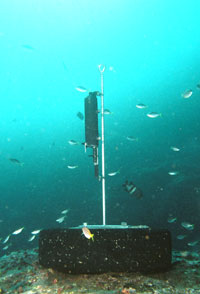
Grey nurse and great white sharks wired for sound and survival

Researchers are hoping to find out more about the endangered grey nurse and great white sharks through a tagging research project that uses special underwater listening devices.
60 acoustic listening stations, part of a system known as SEACAMS (South East Australian Coastal Acoustic Monitoring System), have just been installed by DPI on the seabed at many locations along the New South Wales coast to monitor the movement patterns of the sharks.
Unlike other tagging projects, the listening stations monitor the sharks continuously without the need for human contact.
Over the past few years scientists have fitted grey nurse and great white sharks with electronic tags which continuously transmit the swimming depth of the sharks using sound waves.
It is hoped the monitoring will help establish the exact habitats of the grey nurse and great white sharks and as a result improve protection.
What is known about grey nurse sharks is that they group together or aggregate at certain quite restricted sites along the New South Wales coast.
What is not known is how long individual grey nurse sharks spend at those sites, what they do when they're at those sites, and how big an area around those sites they commonly use.
Each of the listening stations features an acoustic receiver and a temperature logger. The receiver records the identity of the shark (each tag has its own ID code), the depth at which the shark is swimming and the time of detection.
The temperature logger records the temperature of the water at the sites. In combination with other monitoring techniques, this data will provide valuable information about the reproductive cycle of the grey nurse shark, particularly mating and pupping sites.
This system will also be used to examine the movements of bony fish such as black cod and blue groper, other sharks and other commercially and recreationally important fish species.
This state-of-the-art technology is being used around the world on a whole range of species of sharks and fish.
Email:

